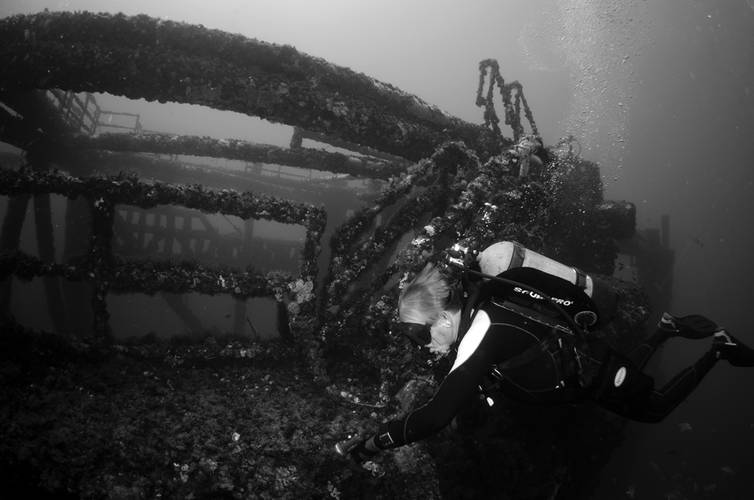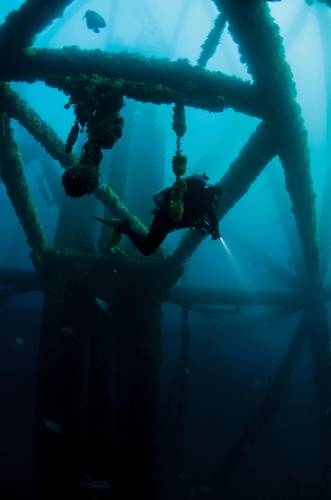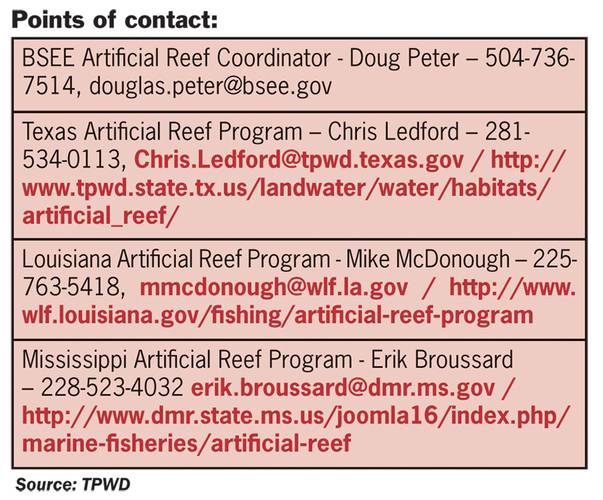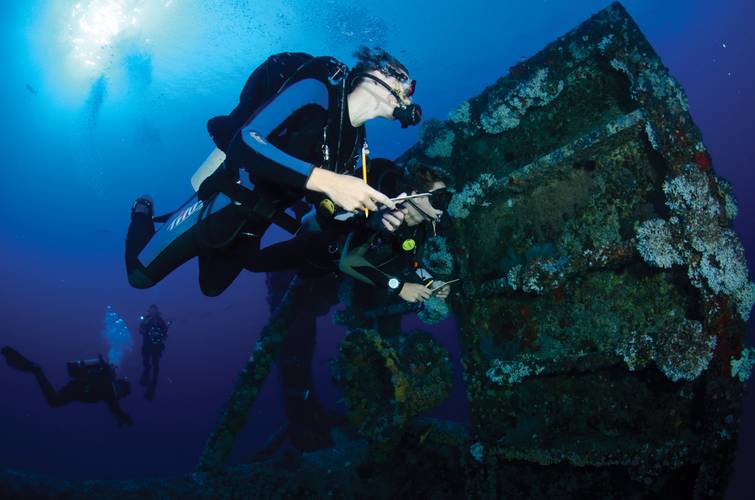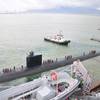Rig Donation: A step-by-step guide
A primer for those interested in Artificial Reefs as a way to dispose of old offshore structures, rigs and ships.
The quandary of what to do with a non-productive well and the associated rig structures has always plagued offshore operators. As federal and state regulations begin to tighten in terms of what has to be done, and when, oil and gas principals are taking a new look at alternatives to removal. Hence, when an operator is looking at options for decommissioning, reefing should be one of the first considerations. Helping to serve that need, the Texas Artificial Reef Program was created in 1990 and is managed by the Texas Parks and Wildlife Department (TPWD).
TPWD and its Domain
Led by three dedicated employees responsible for the entirety of the 367 miles of coastline along Texas, TPWD currently has 68 reef sites between the Mexico and Louisiana borders, ranging as far offshore as 90 miles. Of these sites, 60 are “rigs-to-reef” locations containing over 130 oil and gas structures. The remaining sites consist of nearshore and ship reefs.
The permitted reef sites are generally 40 acres and are large enough to contain multiple reefed jackets. The locations of the sites are determined by water depth, distance from other reef sites and navigational waterways, and the locations of donated platforms. In order for a new reef site to be developed, the jacket must be large enough to be the “anchoring structure” of a site to which additional material can be towed. One aspect of the Texas Artificial Reef Program is monitoring the reef sites. TPWD has a fairly extensive biological monitoring program, and enjoys interagency agreements with Texas A&M University – Corpus Christi, Texas A&M University- Galveston, and the University of Texas at Brownsville. This extends the TPWD monitoring capabilities beyond what a small in-house group can accomplish.
Tracking Rig Removals
One of the biggest challenges facing the Program is tracking rig removals and the TPWD gets significant pressure from recreational users to reef as many structures as possible. Although the TPWD does not expect to reef every structure, there are some that nevertheless get removed that would be ideal for reefing. Typically, this happens because the decommissioning group either doesn’t know about the reefing programs, or think their structure isn’t suitable for donation. Educating the oil and gas industry as to this option is therefore most important.
Through 2012, only about 10 percent of removed rigs have gone into Rigs-to-Reefs programs gulf wide. In an effort to capture more removed structures, the Bureau of Safety and Environmental Enforcement (BSEE) has an Artificial Reef Coordinator, who reviews applications as they come in. If a structure looks like it would be a good candidate for reefing, he will put the operator in touch with an appropriate state reefing program. Unfortunately, the BSEE Artificial Reef Coordinator will only re-direct the operator after they have already filed a removal permit. Time and energy can be saved by approaching the reef programs as a first option.
In a Nutshell: The Rigs-to-Reef Process
A brief step-by-step guide to reefing an oil and gas structure is laid out below:
Starting the conversation: Reefing should be one of the first considerations for decommissioning, primarily because it often offers significant cost savings, and there are potentially more reefing options than might be evident at first glance. The first step is to contact the regional Artificial Reef Program to determine what options are available. Once the contact is made, the Reef Program will need basic information on the structure to determine reefing method; location, number of piles and width dimensions of the base and top.
Site selection: Size of the structure, proximity to the nearest established reef site, and water depth are the primary variables that determine reefing method and location. From a habitat standpoint, reef programs would prefer to reef in place, which usually offers the greatest cost saving to the operators as well. The downside to this method is the permitting process needed to create a new reef site takes significantly longer than towing a structure to a preexisting site. Towing the structure would be recommended if the current position is within a few miles of another site or if it is not large enough to be a suitable “anchor structure” for a new site. For instance, an 8-pile structure tied to an auxiliary 4-pile structure would be reefed in place, even if it was just a couple miles from another reef site, where as a single 4-pile rig would likely be towed to the nearest site.If a structure is to be towed, the distance of the tow and the size of the structure relative to the water depth at the proposed site must be considered. The U.S. Coast Guard generally requests 85 feet of clearance above reef material, but structures provide the best habitat when they are as close to the surface as possible. Hence, agencies such as the TWPD are left with a balancing act of placing structures where they meet the minimum clearance, but at the same time are not too deep.
Permitting the Reef Site: If it is determined that the structure would make a good candidate for reefing in place, the Artificial Reef Program will start the process of obtaining a permit from the U.S. Army Corps of Engineers for a new 40- acre reef site. The only item the Reefing Program would need from the operator is a proposed reefing plat, which would include the coordinates of the center points of the reef site and structure, and pre- and post-reefing profile views with delineated depths. Although the permit application is not overly complex, it can take time. For the past year we have been required to get archaeology surveys completed for every new reef site application, which adds to both time and cost in order to reef in place. With this recent requirement, expect the site permitting process to take about a year. If the structure is being towed, no new site permit is required.
BSEE permits: The operator is responsible for submitting a decommissioning application to BSEE regardless of whether or not reefing is being considered. All decommissioning groups should be familiar with the steps required. If the operator is looking to reef the structure, the decommissioning plan would include the reefing options agreed to between the operator and the state. BSEE and BOEM subject matter experts will review all parts of the application as part of a NEPA analysis, and if necessary delineate required mitigations. Once the mitigations have been addressed, a final NEPA document is issued along with the permit for removal. If the structure is a good candidate for reefing, but the lease will expire prior to the expected reefing date, BSEE is able to make an extension of time for the lease.
Donation: The donation generally amounts to 50 percent of the realized savings, which is the difference in the cost of full removal and scrapping of the jacket and the cost of reefing the structure. These funds are used by the Texas Artificial Reef Program for siting, designing, constructing, monitoring, and otherwise managing the system of artificial reefs in Texas. The majority of the funding to support the Artificial Reef Program comes directly from Rigs-to-Reefs donations.
Material Donation Agreements: Once deployment method and location of the reefing has been determined, permits have been obtained, and a donation amount agreed upon, the Program will work up a Material Donation Agreement (MDA). The MDA states that the structure will go to a specific reef location previously agreed upon by both parties, and once the platform is reefed according to the agreement, the state takes on all liability for the jacket. However, this does not relinquish the operator from liability associated with wells. Once the MDA is signed by both parties, the operator may move forward with removal.
Removal and placement: The operator is responsible for all work and associated costs with reefing the structure. During the reefing process a representative of the Artificial Reef Program may be present as an observer.
Final Survey: Once the structure has been placed on the bottom, a certified survey plat must be provided to the reefing program. The surveys consist of an overall chart of the site including coordinates of the structure and relative locations of other structures within the reef site, a profile view of the structure with depths indicated, and a multi-beam sonar image of the structure in as-reefed position.
After Care: Once the structure is reefed as specified in the MDA and the donation has been received, the state reefing program assumes liability and is responsible for maintaining any required marker buoys, notifying the NOAA charting division of the reefing, and completing biological monitoring on the reef sites.
Reasons to Reef those Rigs
The Gulf coast is fortunate in that artificial reef programs are strongly supported by industry, recreational users and the scientific community. Conflicts of interest are addressed early in the process, and are usually related to placement of the structures. Although technology is moving past the age of fixed platforms, by working together, operators, reefing programs and the public all benefit from keeping many of the current structures in the water to maintain the habitat that has formed around these rigs.
(As published in the January 2014 edition of Marine News - www.marinelink.com)







